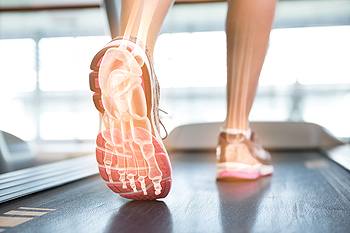
The foot is a fascinating and complicated structure. The entire body is supported by the feet, which consist of 26 bones and numerous tendons, ligaments, and muscles. There are three parts to the foot: the rear, mid, and forefoot. The arch of the foot is instrumental in absorbing the impact that comes from walking and running and acts as a lever that can move the foot. While standing normally, the body is balanced over the center of the foot and this places the greatest amount of stress on the arch. This pressure moves to the heel, which can hold approximately 50% of body weight. Many things naturally happen when walking occurs. The arch and surrounding tissues must absorb the impact as the heel strikes the ground and eventually pushes off as the step is completed. This is typically a smooth and coordinated movement, and any glitches during this process may result in foot pain. Additional stress is put on the ankles and arches with heavy patients, as the entire body works harder while walking. If you would like to know more information about foot structure, please consult with a podiatrist.
If you have any concerns about your feet, contact Dr. John Branwell from Kearny, New Jersey. Our doctor can provide the care you need to keep you pain-free and on your feet.
Biomechanics in Podiatry
Podiatric biomechanics is a particular sector of specialty podiatry with licensed practitioners who are trained to diagnose and treat conditions affecting the foot, ankle and lower leg. Biomechanics deals with the forces that act against the body, causing an interference with the biological structures. It focuses on the movement of the ankle, the foot and the forces that interact with them.
A History of Biomechanics
- Biomechanics dates back to the BC era in Egypt where evidence of professional foot care has been recorded.
- In 1974, biomechanics gained a higher profile from the studies of Merton Root, who claimed that by changing or controlling the forces between the ankle and the foot, corrections or conditions could be implemented to gain strength and coordination in the area.
Modern technological improvements are based on past theories and therapeutic processes that provide a better understanding of podiatric concepts for biomechanics. Computers can provide accurate information about the forces and patterns of the feet and lower legs.
Understanding biomechanics of the feet can help improve and eliminate pain, stopping further stress to the foot.
If you have any questions please feel free to contact our office located in Kearny, NJ . We offer the newest diagnostic and treatment technologies for all your foot and ankle needs.
